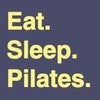Description
About This Video
Transcript
Read Full Transcript
Hi, I'm Shelly power from Pollstar [inaudible] and as a place teacher, I often get asked the question, you know, what do I do? I'm going to have surgery. My own clients asked me this, sometimes I'm going to have surgery. How do I know what to do when I return? Uh, I've had family members and friends who aren't plot eas practitioners are Pilati students. And they often ask to, what do I do? I sprained my ankle. How do I get back to doing what I normally do? So we thought we'd talk a little bit about this. And you can take this in as just a regular person doing PyLadies or as a PyLadies teacher. Cause it really applies to both, both groups of people.
And I would say one of the first most important things is to ask questions. So go to the doctor, go to the surgeon, ask questions, and they'll give you lots of guidelines as to what to do. Sometimes it's going to be don't do this particular activity. And I always ask my clients to ask why. So the more that I know as a teacher, the more I can help them.
If I know exactly what the doctor is referring to of what to avoid, like bearing weight, like maybe they should be on crutches for a while or should avoid a particular movement. If I know why that is, that makes me a better practitioner. So ask a lot of questions. Okay. And the next thing is to know that every person is different. So just because someone else had the same surgery or had a similar, you know, tripped and fell and you know, banged their knee up, doesn't mean that everybody responds the same way. So really listen to your own body, be respectful of that. Um, stay off the Internet if you can, which is difficult these days.
It's such a great source of information, but it's too much information and you get scared. There's a lot of fear. You don't know how to interpret all of this information. So look, don't look too much, has put it away. Um, and really turn, you know, to your own body and really listen, listen to that. That that will help you a lot. Um, the next thing is to realize that a lot of different injuries have different healing times. So sometimes if you break a bone, bones heal pretty quickly. That's not, that's not too difficult to deal with. But tissues like the, like Cartlidge and the [inaudible] and things like that that are more, um, more connective tissue, they have a longer healing time sometimes because they don't have a very good blood supply. The other thing that's kind of interesting, they're doing more and more research on this is how much you actually need to stress or load the tissues.
So I mentioned that sometimes they'll say no weight bearing, but eventually you get back to that. And often right away you've probably heard stories of people who had a hip replacement and the next day they're standing up because we need to start to load these tissues to them, respond appropriately, but we really need to find the balance. So you don't want to do too much or too little in your treatment. So the old, the old feeling of, oh, bed rest is really great. No, not any longer. Not any longer. And we really want to start, you know, listening to the physicians, to our trainers to know how much is too much, how much is enough. One thing that can help, you know, if it's too much is pain. And often I'll have my clients, you know, they'll come back from surgery and they'll say, you know, I e this hurts.
And I asked them, is it, does it hurt or is it just a different sensation? And quite often they'll say, oh no, it's different. It's a different sensation. It's not, it's not the same pain that I had before, but you may feel something. So we use that 24 hour window. So if you've worked out, you know, just working out and lifting some weights, you're like, Oh wow, my biceps hurt today. But by you know, 24 hours, it's really started to subside. So that's a really good marker that if it's been a couple of days and it's not resolving, maybe it's good to check in with your physical therapist or your physician.
So let pain be a guide on that. Some other things that are important and you may be wanting to go to, applaud these teacher. Maybe you've been doing classes here on police any time on your own, which is excellent. But now you want to find a teacher. So by far, word of mouth is a great, it's a great tool. You can look on the Internet and you can look at different views. Um, but really what if people have experienced this teacher and think that they're great. Go for it. That's, that's a good thing to, um, let lead you there.
And also know if this person has experience working with the pathology that you have. So if you had an injury or a surgery, does this person know about that? And even better, do they work in a team of people where you might have access to a physical therapist, a massage therapist that specializes in a mile fashion release? Maybe there's a Feldon Christ practitioner that can help you relearn movement patterns. So a team of people is really great. And I had that opportunity as a really, really young [inaudible] teacher, um, of working with Brent Anderson. And, uh, and a lot of other really good physical therapists and they would say, do this, don't do this. Right? And I would start to learn and then I would know some of those basic guidelines to the point where I was more independent, but I could still, today I'm not sure about the, I'm not sure why this person is feeling this way or this is happening.
Can you come and help me? So a team, a team approach is great. If you already have a teacher, you're already going to see a pilates teacher could also be a yoga teacher or Gyrotonic. It doesn't really matter what the discipline is. If you're already seeing somebody, see if they will communicate, if you feel comfortable with it, with your doctor, with the surgeon, with whoever is doing your primary medical care, that's going to help them understand better. There's a lot of times people will come to us and say, well, I've had this procedure and I may not know exactly what that entails. So if I can speak to the doctor or I can speak to the physical therapist or I can speak to the surgeon, that really helps me.
So even before you go in for something, as you're learning about it, let your plots teacher learn about it too because that's really important. The thing that we sometimes forget is how special the plot equipment is. We don't, but we do, we sometimes get to take it for granted of how much as Pilati as teachers, we can vary the situation. So in using the springs we think about springs is resistance but springs or assistance also. So we can start back in in a very early time of doing some movements, you've probably done some flutter kicking with your legs and you know in a math class when you're moving your legs up and down and there's nothing helping you, you can't do that for very long. It's quite challenging.
But if you go onto the trap table or you're on the reformer with your feet in the straps, you can do that same movement for a long period of time. And so that for pilates teachers is a great tool and if we change our thinking a little bit, it's not resistance, but it's assistance. We can help our clients get back into doing the things that they want to do a little bit sooner without overloading, as I mentioned, overloading the tissues. But we're also not underloading we're, we're doing something that's appropriate. Make sure too that you're really focused on the quality of movement as a teacher or as a student. So it's not just about doing it, but it's about doing it well and maybe being a little more focused on the form, on the alignment of how you're doing things. Start to pay attention to that because that means that you're going to be aligning the bones correctly. Uh, you're going to have all of the tissues working in a really balanced way so that you can hopefully even sooner start to do things a little faster, which is more challenging. Start to do things with a little bit more load, which is more challenging and you will be able to have that whole process take place if your alignment isn't very good.
It's really hard to make progress in healing, no matter what is going on. And even without an injury, it's difficult to move forward unless alignment is pretty good with that sense of alignment. You want to make sure, and this is a change of thought, every time I teach a group of people, they think really is this true, but we need to have mobility in our whole body before we can really have stability. So stability is the control of movement. If I don't have any movement, I don't have anything to control. So the body ends up getting rigid or stiff, which doesn't have control from the nervous system. So in thinking, and this might be something a little bit more of a message for the teachers, is make sure your clients have good mobility everywhere, especially if they have an injury somewhere. Like say it's just an ankle sprain, which is really common. Um, you wouldn't necessarily stop doing everything from the ankle. You know, you can still do leg work. Maybe you're just going to use a strap on the knee instead or you're not gonna put full weight bearing.
But you should be doing your whole [inaudible] program instead of focusing on the ankle. So that's true for every place in the body, really important in the spine. So if you've had a spinal surgery, maybe you had a fusion, and that's a very common now surgery to have where they will fuse two vertebra or three vertebra together. Those vertebra are perfectly safe now, right? Nothing is going to happen there, but the chance that something's gonna move a little bit right above that too much is what we're thinking about. I don't want to have movement right above that's excessive. So I need to make sure that I have movement through my whole spine, really good movement in my hip joints and in my shoulders to prevent that and make sure that I have movement everywhere. So movement, movement, mobility, mobility, really important before stability. So I hope this gives you some things you could think about. Um, if you're going to have a surgery and you're a little bit worried about what to expect if you're coming back from a surgery and you're unsure when you should start piles or not really open up some clear lines of communication with the doctor or with the surgeon, include your plots teacher, because that's really helpful for us.
I appreciate that when my clients do that and get back to moving as soon as you can.
Comments
You need to be a subscriber to post a comment.
Please Log In or Create an Account to start your free trial.

















